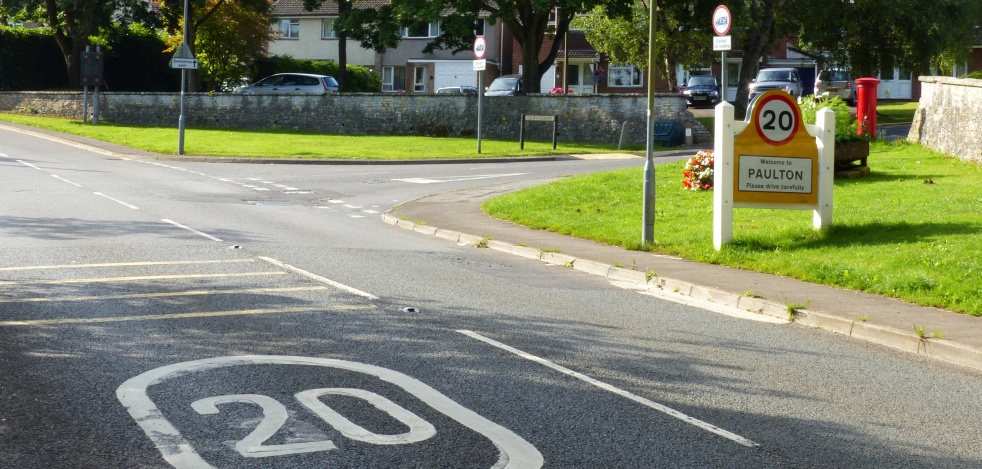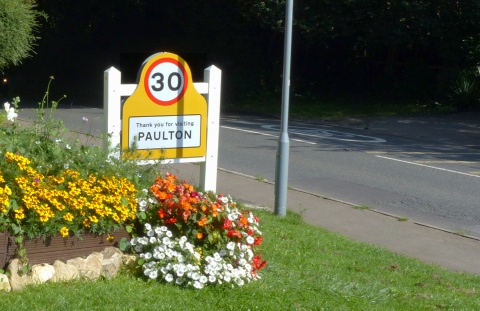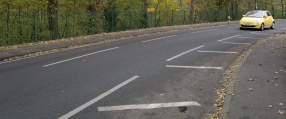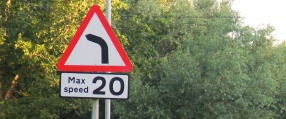Village Gateway - signs and lines

These gateways only have signs and lines, and always display the village name to introduce drivers to the village. In addition, road markings are used to create a visual impact when drivers enter the village. These markings could be:
- Yellow bars
- Coloured road surface
- Dragon's teeth
- Visual Narrowing
These measures have a relatively low cost, and help to create a 'sense of place' when drivers enter the village.
Disadvantages
- It’s very easy for drivers to ignore signs and lines
- Not as effective as physical measures at the gateway
- Dragon's teeth can be hard to maintain because every vehicle drives directly over them, meaning they wear away quickly
Funding for Village Gateways
Somerset County Council may be able to fund the construction of Village Gateways. However, if the Council cannot fund a Gateway, Parish Councils or Community Groups can make a contribution from their own budgets. Developer contributions (S106), from new developments can also help with funding.

Restrictions
- Must be installed just outside the boundary of a village
- Space is required at the side of the road for the gateway sign
- Due to maintenance concerns over Dragon's teeth, they may not be installed
There's also some general restrictions to note for all schemes
Advantages
- Relatively low cost
- Do not cause disruption to buses or emergency vehicles
- Do not cause a problem for cyclists

Effectiveness
Speeds
Some types of signs and lines are effective at reducing motor vehicle speeds, but others have no effect, and could even increase speeds.
- Dragon’s teeth leading up to a red road surface bearing the village speed limit are also likely to be reasonably effective at a village gateway. Speed reductions are expected to be between 1 and 7 mph.
- Some treatments at village gateways were not effective. “SLOW” painted in the road had little or no impact on speeds. Narrowing the lane by painting a hatched area at the outside of the road showed very little speed reduction. Narrowing the lane using a painted hatched area in the centre of the road may increase vehicle speeds marginally.
Accidents
Any measures which reduce vehicle speeds will increase road safety. The measures above are very likely to improve road safety.
There is not enough robust research into the safety effects of signs and lines only gateway treatments to provide any specific safety figures here.
However, research has compared a group of modest gateway treatments (e.g. signage, lining, some minor narrowing) to more intense gateway treatments (e.g. with physical elements) in villages in the UK. The modest gateway treatments reduced all accidents by 19%, whilst the more intense gateways reduced accidents by 45%.
Advanced information
Some of the findings given are based on a good quality simulator research study into speed reducing treatments (Jamson et al., 2010). The research specifically compared UK treatments on UK style roads. The research findings are considered to be very conservative, as the study only recruited young (19 to 25 years old) male drivers – younger drivers, and specifically young male drivers are most likely to be speeding, therefore research which is found to be effective on this group is thought to be at least equally effective on other motor vehicle users.
Results from this study found speed limit countdown signs to be the most effective treatment at village entries. Compared to other treatments, the countdown signs ensured vehicles had already reached a slower speed for the village entry. Other treatments showed drivers started to reduce their speeds closer to the village, entered the village at a higher speed, and continued to decelerate after the village gateway.
For Dragon’s teeth with speed limit markings on a red background, three good quality studies were used to reach the figure given. A study from Iowa State University introduced this treatment in isolation from any other intervention. It found relatively modest speed reduction of between 1 and 2 mph. The study design is good, assessing vehicle speeds over a long time period using a covert data collection technique, however there were no control points used, and only three instances were analysed. The second study, from the Federal Highway Administration (FHWA) of the United States implemented only the speed limit markings with a red background. At a 35 mph speed limit, results showed reductions of 1 to 7 mph in the 85th percentile speed in most situations. This study used three sites for analysis, and the results are based on large sample size, however there were no control points used. The third research piece is the aforementioned study from Jamson et al. It found mean speed reductions of around 6 mph at a 30 mph speed limit village gateway when using dragon’s teeth only, in comparison to when there were no dragon’s teeth. Based on these three studies, the range of 1 to 7mph speed reduction is reached.
For crash reduction at village gateways, all information is based on research from the Transportation Research Laboratory (TRL 452). For this study, multiple designs for traffic calming through villages were grouped based on similar characteristics. The study design is strong, with a large selection of sites, and long analysis periods before and after intervention. The research provides evidence that measures which move towards more physical elements are the most effective. The accident reduction figures given can only be used as a rough guide, as the village gateway measures compared on this page differ somewhat from those analysed in the research.
There’s a further noteworthy piece of research not mentioned above. TRL 641 studied ‘psychological traffic calming’. The report highlights traffic calming measures which increase cognitive load; create uncertainty; emphasise a change of environment; and break up linearity. The authors state that these elements reduce vehicle speeds considerably, due to the changes they have on the driver’s thought process. This research only backed up this theory with analysis of one village implementation in the U.K. – measures included; removing the centre line; build-outs with tree planting (to create a chicane effect); stone gateways to the village; and buff coloured road sections in pedestrian heavy areas.
Recommendation
Physical measures are more effective than just signs and lines alone. Physical measures are more expensive however, and could be unpopular with some residents and motorists.
The best approach will be to use the signage and road markings recommended above, and to move towards physical measures if this does not help to cure the issue.
Speed cameras can also be very effective at reducing vehicle speeds through a village.
References
TBC








